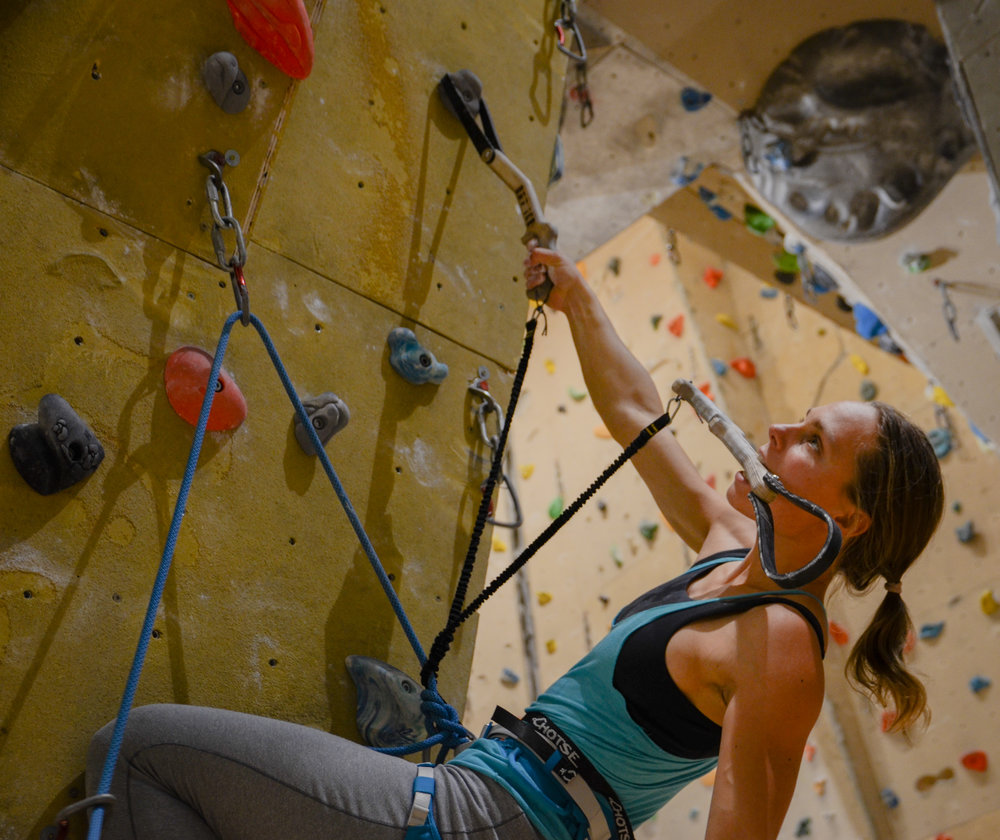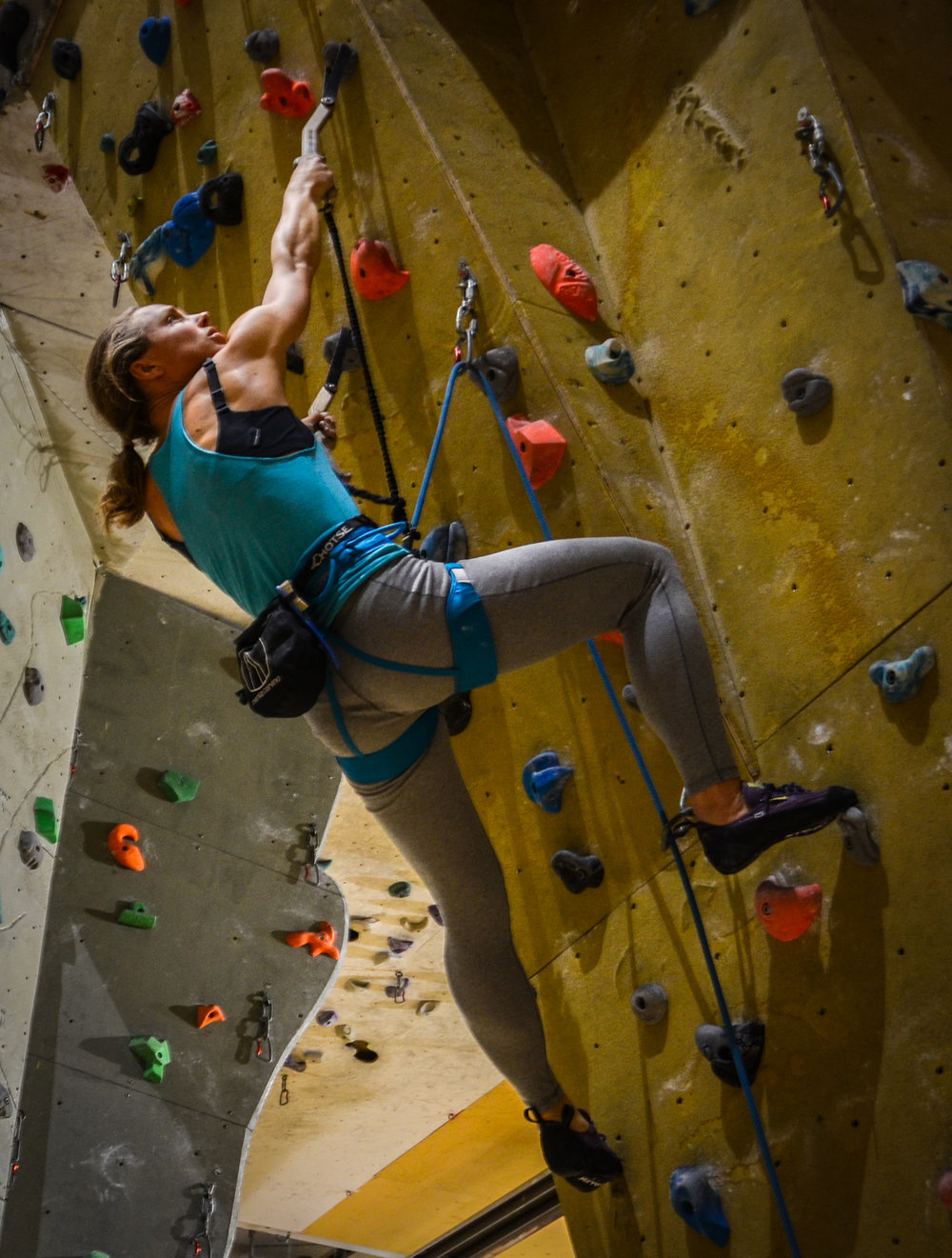I am an ice climber, or more accurately, a climber. I climb everything. Buildings and industrial structures for work, bouldering for strength and social fun, rock routes because I love that, alpine routes because I sometimes like to suffer, and mixed because I love the awkward technical leverages you do with those sharp tools! I love climbing comps too. World Cup events and stuff like that.
For the past few weeks I've been living in Germany at the edge of the Alps in the region Allgäu. I'm originally Dutch. In the flat country where I was born we only have climbing gyms. No rocks, not even small ones, not even ones small enough to trip over. Really. The Netherlands is just all sand, mud, and water. That makes it pretty hard to train for ice climbing. We only have horizontal ice. Probably the reason Dutch are rather good in speed skating.
The chance to move to Germany was amazing! My boyfriend, Dennis, is writing his final paper for his studies in Industrial Design at a climbing gear company, based in Southern Germany. Being without my boyfriend for longer then a month just doesn't work. I gave up all I had, even the fridge, couch, my house and my job and moved in with Dennis. I didn't even have a job yet. Luckily the gear company Dennis now works for was super sweet and offered me a job too! Yay!
My regular training day now goes like this:
Wake up > eat a banana > run to work (8km) > shower > eat breakfast and work > go bouldering during lunch > eat lunch when working > work till late and drive back with colleagues or with Dennis > eat some food > cycle to the climbing gym > climb till 10p > cycle back home> sleep.

Recently we found ourselves in Starzlachklamm, a dark, wet, sketchy cave that just calls for dry tooling, coffee, climbing, and more climbing. A perfect way to spend a weekend. On Sundays we go sport climbing outdoors. It’s very awkward to me that you can just go outdoors whenever you want. We don't have that back home in the Netherlands.
During the weekdays it’s usually dark when we get home. It makes no sense to climb outdoors, so a great alternative for training for ice climbing are the DRY ICE Tools. And I'm one of the lucky ones that received a pair! I had used them a couple times in the Dutch gyms. There, people looked at me like I was crazy and playing a dangerous game. They had the regular non-ice climber comments: "oh, that’s so easy, you're just holding on to this big grip all the time" or "now you've got so much more reach, that makes climbing just so easy now".
Right. Just try it.

Here in Germany the voices are surprisingly different. The first time we pulled out the tools people stopped climbing to watch us. They wondered what these strange tools were and understood immediately that we were serious about the winter climbing season. Soon after, two other climbers tried to make replicas and we're starting to have rather fun group tooling sessions in the boulder room (wow, that last bit of this sentence probably sounds weird if you're a non-climber).

Dennis also has a another brand for his indoor ice tools. He got yet a pair from a Scottish friend. We can clearly say the rubber strap on the DRY ICE Tools give by far a better grip on the holds compared to the other two brands that we've tried. Also the DRY ICE Tool handles are shaped differently. DRY ICE Tools are more comfortable and more realistic than the Scottish tools, closer to the design of real ice climbing tools that we use in during competition. It can still have a little tweaking though. We think the upper grip of the tools can be made a little more comfortable by lengthening the pink-rest on the upper grip.
We can easily do figure fours and even make long, reachy swing moves with the tools. Our heavy 95+kg (about 210lbs!) friend Axel climbed with DRY ICE Tools and even he could easily swing around in the roof, proof that the tools are plenty strong.
When lead climbing we use BD Spinner Leashes. We want to prevent the possibility of dropping the tools. If we accidentally dropped a tool on another climber or belayer, we'd be screwed. In the Netherlands all the gyms are just toprope, we'd still use leashes then. The tricky thing when leading is to manage the possibility of fall when clipping. If you fall and leave the tool on the hold, then you're hanging in your leash. In order to reduce that possibility, we developed a method. When clipping: One tool hangs your thumb of the hand that you’re holding on to the other tool (see photo below). The other hand is then free to clip. If you happen to fall you'll just hang on the rope, not the leash.

After much use, the handles on my DRY ICE Tools are still not getting greasy. I do not use gloves and when my hands get sweaty, I sometimes even chalk up. In this way I’m finding that I’m growing thicker skin, which is useful for long winter routes.
It is, however, challenging to train for precision using DRY ICE Tools compared to using real ice tools on holds. You rarely have the same sketchy tricky moves on which you need 200% body tension. But DRY ICE Tools are clearly safer and than using real tools in the gym. To train precision and tension, we simply to go outdoors and rock it on the real stuff.

It's funny how different it is to climb with ice tools. I can climb hard sports routes with my hands in the summer, but then at the start of the winter season I really need to build up a specific kind of strength again. Though there is a big overlap, the muscles that I need for the ice climbing are different from the ones I need for sport climbing. Being able to climb with DRY ICE Tools allows me to get strong for ice before the ice season even begins.
To see what Marianne and Dennis are up to today, check out her phenomally inspiring blog at www.lavinia-marianne.blogspot.com
